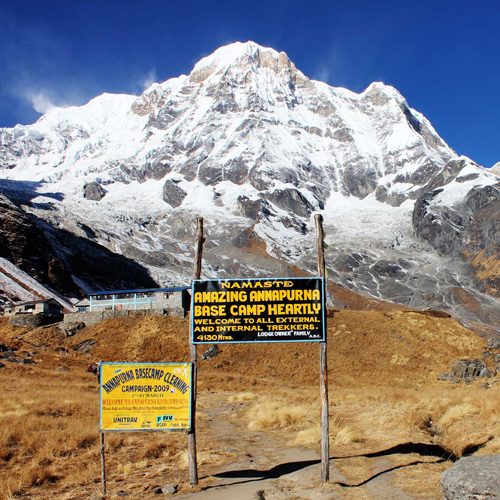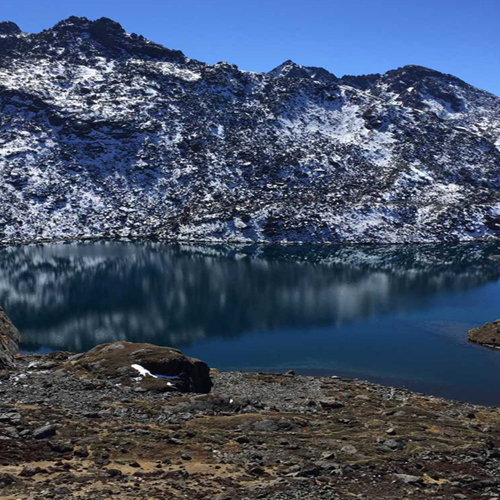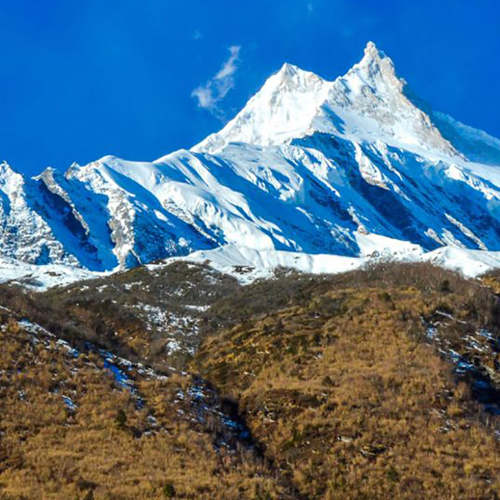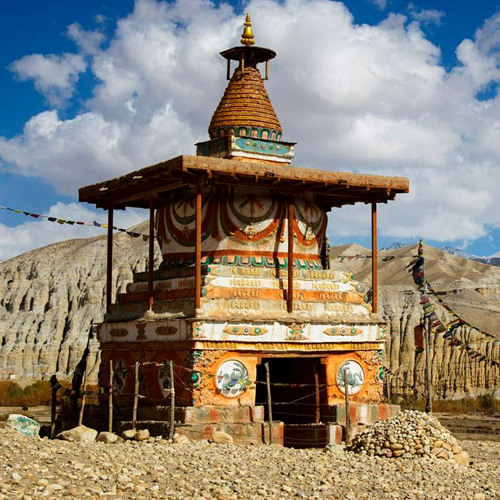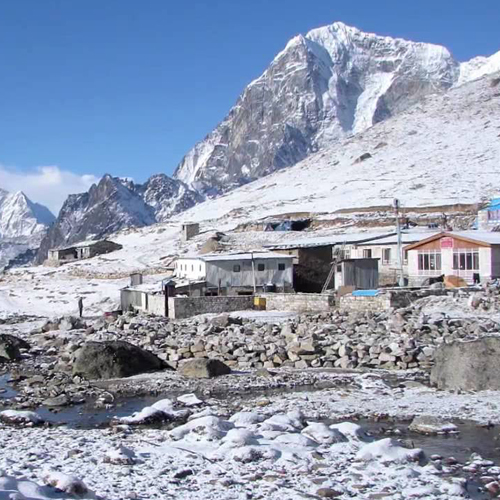Day 01: Meet at the group hotel in Kathmandu.
Transfers from Kathmandu Airport are provided. Arriving in Kathmandu we are met outside the arrivals hall by a local KE representative who will arrange the transfer to the group hotel in the heart of the city. KE Land Only package services begin with this transfer. Depending on flight times there may be time to look around the area of Thamel before rendezvousing with the group for dinner, where you will also be given information on timings for tomorrow's flight to Bhutan.
Day 02: Fly to Paro in the Kingdom of Bhutan
We transfer to the airport for the Druk Air flight to Bhutan's main international airport at Paro. The flight from Kathmandu to Bhutan is one of the most spectacular of all mountain flights. From the left side of the plane Everest, Makalu and Kangchenjunga, three of the world's highest mountains, are clearly visible. The total flying time is only 45 minutes and soon we are descending into the Paro Valley, enjoying the splendid views of alpine forests, small monasteries, temples and flat-roofed farmhouses. You will receive a warm welcome from our Bhutanese hosts who will assist with the transfer to the hotel. The Paro Valley is enchanting. A single road lined with willows, clear mountain streams, families working in the roadside fields and one of Bhutan's most impressive Dzongs (fortress monasteries) creates a memorable first impression. After checking into our hotel in Paro the rest of the day is free to look around the town. Overnight at the group hotel.
Day 03: Hike to the Taktsang (Tiger's Nest) Monastery (3120m).
This morning we make the stunning hike up to one of the most important religious site in the entire Himalaya, the Tiger's Nest. The monastery has a most stunning location, perched on the ledge of a cliff 900m above the Paro Valley, and is only accessible on foot. Not just a cultural experience, this hike up to over 3000m will provide some excellent acclimatisation ahead of our trek. Around half way up the trail there is a classic viewpoint for Takstang, looking across the gorge to the monastic buildings clinging to the cliff wall opposite. There is a small teahouse located here where we can stop for a rest and a drink with a truly unforgettable view. The final approach to the monastery takes us down to a sacred waterfall, surrounded by a thousand fluttering prayer flags, where every crack in the rock is crammed with tsa-tsas (small caskets containing the ashes of the dead), before climbing back up towards the monastery. Leaving our bags and cameras at the gate we should hopefully be allowed to take a look around inside. As we explore amongst the various atmospheric chambers and altar rooms our guide will be on hand to explain all about the Buddhist rituals and iconography. We return to Paro in the afternoon. Tonight we will want to repack our bags ready for beginning our trek in the morning. You may leave some items you won't need on the trek at the hotel.
Day 04: Drive to Shana (2860m) to begin our trek. Hike to Thongbu Samba (3104m)
From Paro we drive west for 30 minutes to the end of the surfaced road at the ruins of Drugyel Dzong (2530m). From here we continue following a farm road for around 1 - 1.5 hours, passing through small hamlets of houses built in traditional Bhutanese design. Arriving at the end of the farm road at Shana (2860m), we will be happy to stretch our legs. While our bags are loaded on the ponies we will set off following a path beside the river before climbing to our first night's camp at Thongbu Samba (3104m).
Day 05: Trek to Soi Thangka (3650m).
Today we will gain height slowly as we continue along the river through a magnificent forest of pine and spruce, mixed with oak, birch and maple. The autumn colours of the leaves contrasts with the Pale Spanish moss (old man's beard) festoons many of the trees. After rain the trail can be muddy in places and where we cross streams there will possibly be slippery rocks to contend with, however, our local guides will be on hand to assist anyone if necessary. There are several small ups and downs today as we follow the river north and after crossing a bridge at 3560m. we make a short steep climb to reach a junction of two valleys, marked by a large chorten. There is a bridge here from where, weather permitting, we can see Chomolhari at the head of the valley. Our trail stays on the west bank of the Paro Chu and our next camp at Soi Thangka is only a half an hour's walk away.
Day 06: Acclimatisation trek to Hermit's Cave (4300m). Descend back to camp at glacial meadow (3900m).
An important day for acclimatisation ahead of reaching Chomolhari Basecamp and crossing the Nyele La (4850m). We continue following the ancient mule trail that keeps to the left of the PaChu up to a camp at around 4000m. This trail slowly rises through old juniper trees and meadows in which yaks graze. We pass a small Royal Bhutan Army outpost and then in about 1.5 hrs we reach a large meadow with a lone white chorten. From the chorten in the meadow we take the trail on the right that starts with a steep climb up a small hill. In about a half hour we reach a beautiful meadow decorated with small birch trees and rhododendrons. A further 2hrs hiking will take us to the upper part of this scenic meadow, where lunch will be served. After lunch, we hike on past a few meditation centres or 'drup khang'. The complete solitude of this region has in the past drawn several important historical figures to this area to meditate, such as the great saint Guru Rinpoche who travelled here in the 8th century and in recent times a highly-respected Thai Burmese Monk, Kuba Rinpoche who spent time meditating here. We hike back down to a glacial meadow at lower elevation (3900m) where we will camp for the night.
Day 07: Trek to Jangothang (4100m).
First we must back track a little on the previous day's trail before continuing our hike on the trails of the cow herders up to the small hamlet of Jumphu. From here we re-join the main trekking trail to today's camp at Jangothang, a beautiful grassy at the base of Mt Chomolhari. We have lunch in a meadow at Tikithang, just before we reach the school at Soi, The school children here have developed a habit of conversing with trekkers to practice their spoken English and, if the school is open, they may sing some nursery rhyme for us. From the school it is another hour's hike to the camp. Our camp tonight is next to a ruined dzong (4100m) beneath the huge east face of
Day 08: A rest day at Jangothang.
Today is a scheduled rest day, intended to aid everyone's acclimatisation before the crossing of the Nyele La to Lingshi. There are plenty of options for a walk, and one possibility is a hike up the ridge behind the ruined dzong to a grassy summit at approximately 4500m, from where there is an incredible close-up view of Chomolhari. Alternatively, a 2-hour hike to a lake above camp provides a stunning location for photographs of Jitchu Drake. Green grass, grazing yaks, stunning mountain scenery - it doesn't come much better than this. For a spectacular view of Jitchu Drake closer to camp (even better at sunrise if you can get up sufficiently early), follow the river for 20 minutes to a lone house and here the mountain is presented before you. No matter what you choose to do today, the cooks will have had all day to prepare dinner and a veritable banquet will be waiting at the end of the day.
Day 09: Cross the Nyele La (4850m) to Lingshi and descend to camp.
One of the longest days of the trek, as we climb to cross the Nyele La to reach Lingshi. We follow the river for a while, crossing on a bridge close to the house at the end of the valley where Michael Palin met with the old Bhutanese composer during the filming of his Himalaya series. Climbing steeply at first, this path offers views toward Chomolhari and Jitchu Drake which are some of the finest of the trip. We are now very near the Tibetan Border as we make our way along a broad hanging valley to the final steep slopes leading to the Nyele La (4850m), which is adorned with prayer flags. From the pass we descend, steeply at first, to follow a long ridge before finally dropping through forests of rhododendron and pine to our camp beside the river.
Day 10: Trek to Shagay Pasa (4050m) via Chebisa and Gangyul across Gobu La (4445m).
After breakfast, we climb up to Lingshi Dzong. The dzong is currently under renovation and the monks have taken refuge in the nearby village. From here a our path contours the hillside, passing by farms. There are views across the valley to the Basingthang Peaks and we can watch kestrels (almost identical to the European variety) hovering above the ridges. After a couple of hours the path turns a corner and there is a view of Tserim Gang, before we descend to Gang Yul (meaning 'village at the pass'). Set beneath e limestone cliffs and dwarfed by the enormous east face of Jitchu Drake, Gang Yul's situation is one of the most impressive in Bhutan. Home to about 150 people, living in a dozen or so beautifully designed houses, this village offers endless photo opportunities. We may even be lucky enough to be invited into a house to try chang (locally brewed drink) and roasted rice here. Leaving the village, the path continues along the hillside to Chebisa. From here, the path gradually climbs high above the river to the Gobu La (4405m). Although conquering a pass, this is a lovely walk. The pass also offers specular view of Tiger Mountain (Gangchen Taag) and we should also see blue sheep and eagles on this day. Tonight we camp at Shagay pasa nearby a glacial stream.
Day 11: Cross the Jhari La (4720m) to Robluthang (4200m).
From Shagi Pasa, the path contours across the hillside and then climbs steeply into a side valley, from where we climb up to the Jhari La (4720m). The views from the pass are stunning, especially the view of Tiger Mountain. Our next objective, the Shinge La, is the lowest point of the horizon opposite. As we descend through glorious pine forest into Tsharithang, we keep a look out for takin, the national animal of Bhutan which are quite common in this part of Bhutan. The scenery on this day's walk is breathtaking - it inspired Victor Saunders, one of Britain's most travelled Himalayan climbers, to comment that this was the best walking he'd ever done! We cross a river and camp in a very scenic position just half an hour's walk up the hillside, at a place known as Robluthang (4200m).
Day 12: Cross the Shinge La (5000m) to Limithang (4050m).
An obvious yak trail, scarring the hillside, can be seen directly above the camp. This is followed to a beautiful hanging valley with a lone yak herders hut, two hours above the camp. The path takes the left side of the valley and soon the Shinge La (5000m) is visible. The final climb is quite strenuous, but save some energy to place a small stone on one of the four cairns that mark the end of the climbing. Prayer flags and dried leaves enhance the fascination of this pass which marks the boundary of the Laya District. Our descent follows an obvious path into the centre of the valley, to a clearing by a huge rock. We continue descending until we see a bank of moraine, which is holding back a very picturesque lake. The backdrop to this beautiful valley is Kang Che Da, the Great Tiger Mountain. We camp a short way down the valley at Limithang (4050m), in a meadow by the river.
Day 13: Arrive into Laya (3800m).
A beautiful morning's walk today through a bird spotter's paradise. Although shorter than some of the days so far, there is quite a lot of up and down. We cross a bridge and follow the left bank of the river on an undulating trail through more forest of spruce and juniper. As we descend we start to see Spanish moss once again hanging from the trees. The path then gradually climbs above the river and soon we see the first houses on the outskirts of Laya (3800m). The people of this fascinating village are very friendly and they present a most unusual and striking picture, with their pointed hats, hair covered in mustard oil and highly decorative jewellery. We aim to arrive in Laya in time for lunch and have the afternoon free to look around the village and to visit the hillside monastery. We set up camp on one of the village fields. In the autumn season the fields have been harvested and finding a camping place is easy.
Day 14: Morning in Laya village. Trek to Tongchu Drak (3300m).
This morning we have the option to further explore Laya village. Laya, one of the most distinctive villages in Bhutan, located on a shelf. As with most villages in the high Himalaya, cultivation is difficult. The villagers are semi-nomadic and rely on yak herding for a livelihood. They spend most of the year in black tents woven from yak hair, but they also build drystone-walled houses, which serve as shelter during the coldest months and as storehouses for their goods and grains, which they use to barter for goods with the central valleys. From Laya, we descend to the Mo Chu to begin our walk-out to Gasa. The main path from the village descends to the lowest house, passes through a large entrance chorten and drops down to the river. During the monsoon, from June to September, this valley receives a great deal of rainfall and as a result the forest and jungle is particularly lush and impressive. We pass through a small army outpost and continue on a trail alongside the Mo Chu (mother river). Although the overall tendency is to descend, there are many places where the path has to climb quite high above the river to negotiate steep spurs. We will camp at Tongchu Drak near the Mo Chu river in a meadow.
Day 15: Trek to Gasa (2500m).
From our camp we walk about 2hrs to Koina. The Saint Shabdrung from the 17th Century took a rest day here when he made his journey from Tibet. From the Koina old camp we trek through bamboo, fir, maple and larch tree to the road head in Ponjothang. We continue dropping down through splendid sub-tropical forest, the trekking on this part of our route is a sheer delight. Huge banana plants, bamboo and an array of exotic plant life make this part of the trek a botanist's paradise. If the road conditions are good, our vehicle can pick us up halfway through the hike. Passing Gasa Dzong, which used to control the routes to the religious areas of Lunana and Laya with its dominating position high above the Mo Chu, we reach the Gasa Tsachu (hot spring) where many people from all over Bhutan come to bathe. We also have the option to soak after long days of walk. We camp nearby the hot springs.
Day 16: Drive to Thimphu, via Punakha en route.
Getting an early start we drive alongside the Mo Chu through Damji and across several ridges steadily descending. As the valley becomes more populated we begin to encounter rice fields, scattered little hamlets and villagers about their work. Eventually we reach Punakha (1350m), which was the winter capital of Bhutan for more than 300 years. Punakha Dzong lies at the junction of the Mo (mother) Chu and the Po (father) Chu and, in winter, is home to over 1000 monks. From Punakha we drive to Thimpu on Bhutan's remarkable east-west highway, which winds its way up to the Dochu La (3050m). The pass is marked by many prayer flags and a large chorten. The road winds its way down from the pass, passing through Hongsto, an ancient village founded in 1525 by the 14th Drukpa hierarchy of Tibet, to arrive at the relatively modern capital of Thimpu. We check into our hotel where we can clean up before sitting down to a celebratory evening meal.
Day 17: Fly to Kathmandu. Afternoon free for independent sightseeing.
We have an early transfer to Paro Airport for the morning flight to Kathmandu. The flight takes only 45 minutes and on arrival we transfer to our comfortable hotel. The remainder of the day is free to explore the city or for shopping in the bazaars. An evening meal is included at the hotel, for those that wish to dine together, or you are free to head out into Thamel independently to a restaurant of your choice.
Day 18: Departure day. Transfers to Kathmandu Airport are provided.
KE Land Only package services end after breakfast. Transfers to Kathmandu airport are provided. There are lots of extensions that can easily be added to your holiday. Why not pre-book a simple full day-tour in the Kathmandu Valley, or a multi-day excursion to wildlife reserve at Chitwan. Contact the KE office for more details.

